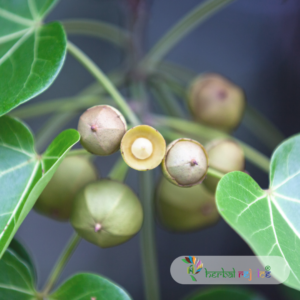Introduction
Thespesia populnea Soland. ex Correa, also known as Portia tree, Tulip tree, Umbrella tree, or False Rosewood, belongs to the family Malvaceae. This plant is native to coastal regions of India and the Andamans, and it is also cultivated as an ornamental plant.
Therauptic Potential
In Ayurveda, Thespesia populnea is known as Paarisha, Kapitana, Paarshvpippala, and Gardabhaanda. In Siddha medicine, it is called Poovarsu. This plant has been used for its specific action against skin diseases. The root, fruit, and leaf of Thespesia populnea are used in the treatment of psoriasis, scabies, and other cutaneous diseases. The presence of lupenone, lupeol, and alkanes in this plant show activity against both Gram-positive and Gram-negative bacteria. The bark of Thespesia populnea is traditionally used for the treatment of hemorrhoids and chronic dysentery. The leaf of this plant also possesses anti-inflammatory properties.

Chemical Components
The flowers of Thespesia populnea contain various chemical compounds such as populnetin, herbacetin, populneol, quercetin and its glycosides, kaempferol and its glycosides, rutin, gossypol, beta-sitosterol and its glycosides, nonacosane, lupenone, myricyl alcohol, lupeol, and gossypetin. Fruits of Thespesia populnea have been reported to contain thespesin (0.4%) and herbacetin. Thespesin has been identified as an optically active gossypol. Gossypol, which is found in cotton plants, is optically inactive. However, the gossypol from Thespesia populnea has a high dextro-rotation. Thespesin exhibits various pharmacological activities including antifertility, anti-tumor, anti-amoebic, and anti-HIV activities. Extracts from the fruits of Thespesia populnea have shown antiviral and anticancer activity in mice.
Conclusion
In conclusion, Thespesia populnea (Portia tree, Tulip tree, Umbrella tree, False Rosewood) is a plant with significant medicinal properties. Its root, fruit, and leaf are used in the treatment of skin diseases, while its bark is used for hemorrhoids and chronic dysentery. The flowers and fruits of this plant contain various bioactive compounds that have shown a range of pharmacological activities, including antifertility, anti-tumor, anti-amoebic, and anti-HIV activities. Further research is needed to explore the full potential of Thespesia populnea in medicine.
Frequently Asked Questions
What is Thespesia populnea?
Thespesia populnea, also known as Portia tree, Tulip tree, Umbrella tree, or False Rosewood, is a plant belonging to the family Malvaceae.
Where is Thespesia populnea native to?
Thespesia populnea is native to coastal regions of India and the Andamans.
Can Thespesia populnea be grown as an ornamental plant?
Yes, Thespesia populnea can be cultivated as an ornamental plant.
What is Thespesia populnea called in Ayurveda?
In Ayurveda, Thespesia populnea is known as Paarisha, Kapitana, Paarshvpippala, and Gardabhaanda.
What is Thespesia populnea called in Siddha medicine?
In Siddha medicine, Thespesia populnea is called Poovarsu.
What are the medicinal uses of Thespesia populnea?
The root, fruit, and leaf of Thespesia populnea are used in the treatment of psoriasis, scabies, and other cutaneous diseases.
Does Thespesia populnea have antibacterial properties?
Yes, Thespesia populnea shows activity against both Gram-positive and Gram-negative bacteria.
What is the traditional use of Thespesia populnea bark?
The bark of Thespesia populnea is traditionally used for the treatment of hemorrhoids and chronic dysentery.
Does Thespesia populnea have anti-inflammatory properties?
Yes, the leaf of Thespesia populnea possesses anti-inflammatory properties.
What chemical compounds are present in Thespesia populnea flowers?
The flowers of Thespesia populnea contain various compounds such as populnetin, herbacetin, populneol, quercetin and its glycosides, kaempferol and its glycosides, rutin, gossypol, beta-sitosterol and its glycosides, nonacosane, lupenone, myricyl alcohol, lupeol, and gossypetin.
What compounds are found in Thespesia populnea fruits?
Fruits of Thespesia populnea contain thespesin and herbacetin.
What is the pharmacological activity of thespesin?
Thespesin exhibits various pharmacological activities including antifertility, anti-tumor, anti-amoebic, and anti-HIV activities.
Does Thespesia populnea have antiviral activity?
Yes, extracts from the fruits of Thespesia populnea have shown antiviral activity.
Does Thespesia populnea have anticancer activity?
Yes, extracts from the fruits of Thespesia populnea have shown anticancer activity in mice.
What is gossypol?
Gossypol is a compound found in cotton plants.
Is the gossypol in Thespesia populnea the same as in cotton plants?
The gossypol from Thespesia populnea is different from the gossypol found in cotton plants, as it has a high dextro-rotation.
What are the potential medicinal applications of Thespesia populnea?
Thespesia populnea has potential medicinal applications in the treatment of skin diseases, hemorrhoids, chronic dysentery, antifertility, anti-tumor, anti-amoebic, anti-HIV, and antiviral activities.
Are there any side effects associated with Thespesia populnea?
This information is not provided in the text.
Is further research needed on Thespesia populnea?
Yes, further research is needed to explore the full potential of Thespesia populnea in medicine.
Can Thespesia populnea be used as a natural remedy?
Based on its medicinal properties, Thespesia populnea can potentially be used as a natural remedy, but further research is needed.


